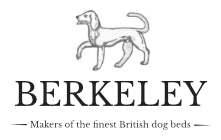There is a growing consumer demand for 'Non-Toxic Dog Beds', 'Natural Dog Beds', 'Organic Dog Beds', 'Eco-Dog Beds' or 'Chemical-Free Dog Beds'
This article highlights the background to this trend in order for you to make a more informed decision the next time you are ready to purchase a new dog bed for YOUR best friend.
Background
Your dog's bed is probably the most used and abused piece of furniture in your home. It is scratched, chewed, licked, jumped upon, soaked, shaken, dragged around and played with virtually every single day.
However, few people are aware of the potential threat that this innocuous item of furniture in the corner of your kitchen or living room could represent to the health of your pet and other family members.
So what is the problem?
As far as your dog bed is concerned, let's split this down into two key areas – 'What's in it?' and 'What's on it?'
What's in it?
Many dog beds these days are made with some form of foam, with Memory Foam being the fashionable solution for so called 'orthopaedic' dog beds.
From a manufacturer's perspective, foam in all its forms is great!
It's light, easy to cut and shape, it can be glued and it can be compressed for ease of transport / storage.
Moreover, it's cheap – especially when sourced from largely unregulated exporting countries.
In use, the theory is that they shape and mould to your dog's body to provide consistent support.
However, it may turn out that your dog's sleep is not as comfortable as expected — once he / she sinks into the mattress it is very difficult to move and it can also feel overly hot.
Crucially, you might not realise that nearly all memory foam contains harmful Volatile Organic Compounds – 'VOC's.
VOC's are present in an alarming number of items of household furniture.
Rather like asbestos, if the item is left undisturbed, it doesn't represent such an area of concern.
However, as highlighted above, your dog's bed doesn't fall into this category.
Many of these VOC's found in the home have been found to have a plethora of negative health effects, on both 4 legged and 2 legged occupants, ranging from worsened allergy symptoms, to cancer and developmental effects. Studies on VOCs and the harmful flame-retardants often used in furniture and household appliances have highlighted potential links to each of the following:
Eye, nose, and throat irritation including asthma
Headaches, nausea and dizziness
Fatigue
Damage to the liver, kidney, and central nervous system
Allergic skin reactions including eczema
Cognitive issues including reduced IQ in children
Behavioral Issues
Decreased fertility
Cancers including Thyroid, Leukaemia and Lymphoma
What's on it?
Did you know that almost all beds and mattresses (including dog beds) are soaked in flame retardant chemicals?
This would appear to be a wise move as many constituents of such items are highly flammable.
Unfortunately, it transpires that many of these chemicals also cause significant harm as they are absorbed through breathing, skin contact and ingestion.
There is also a growing school of thought that their efficiency at reducing household fires is questionable and counterproductive given the highly toxic smoke given off when subject to actual fire conditions.
So what can you do?
If you already have a fancy new Memory Foam Dog Bed and you are reluctant to commit it to landfill or incineration, it is worth taking a few precautions
Site the bed in a low traffic area of your home with a good level of ventilation
Clean, vacuum and air the bed regularly
Consider covering the bed ideally with an impermeable cover or at least some additional non-toxic blankets.
If you are actively in the market for a new dog bed, it's worth doing your research
Here at Berkeley Dog Beds, we have a company policy of not (and never) using foam or memory foam in our dog beds and we prefer to use natural dog bed fillings that are then wrapped in lambswool which is a natural flame retardant to help keep your pet and family safe.
 Handmade In the UK
Handmade In the UK

